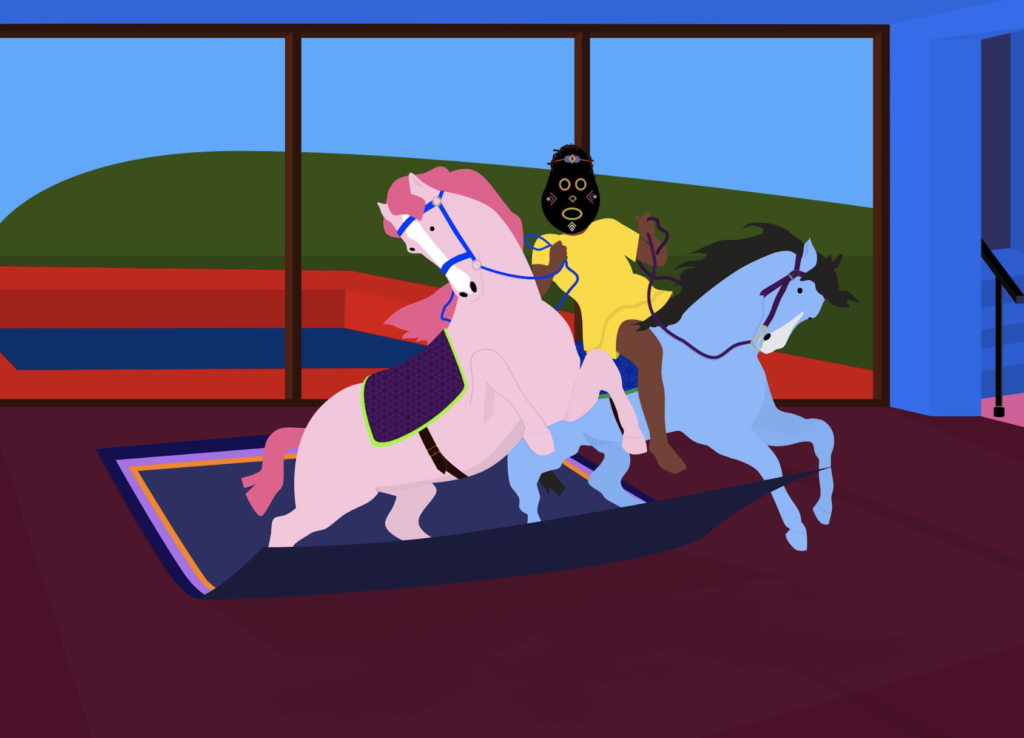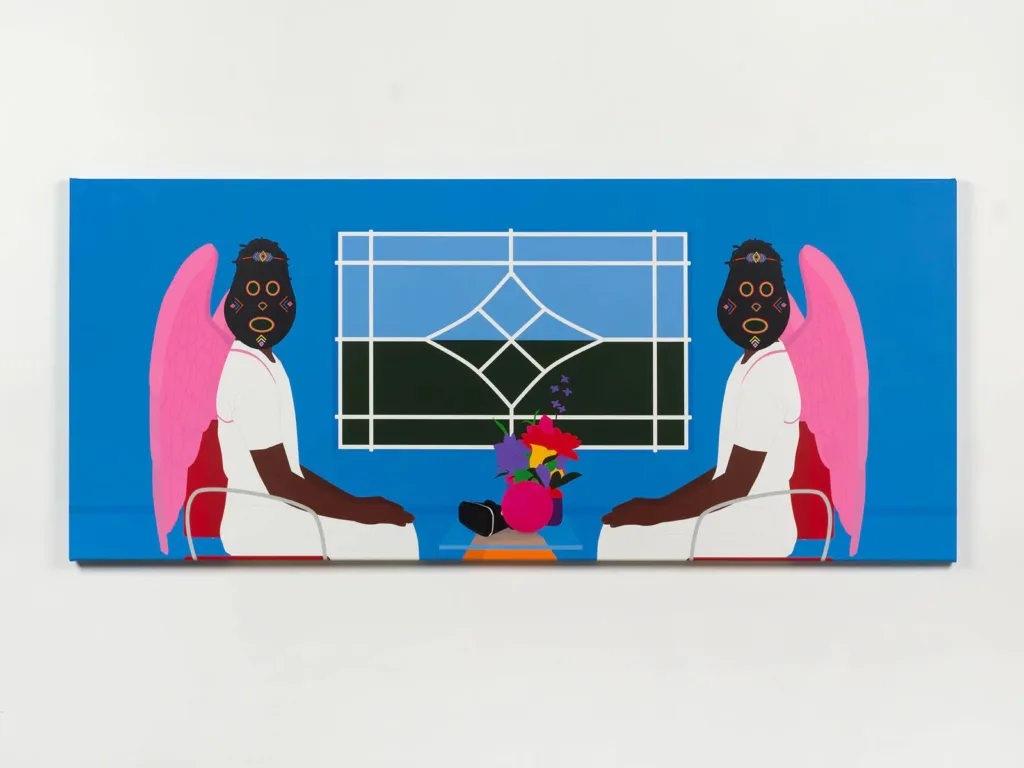Through the use of uplifting, thought-provoking, and forward-thinking imagery and narratives, Osadebe’s vibrant post-pop style seeks to reimagine Africa. To create a dialogue where custom meets invention and innovation. Dennis Osadebe places Africa in the context of the future. Its limitless possibilities by contrasting aspects from the past and the present. To truly encapsulate his expression, Osadebe coined the term, “Neo – African Art”, while using his Nigerian heritage as a starting point.

A.S: There is a lot of symbolism and storytelling in your work. How do you get inspired to begin that story?
D.O: Visual work is a language in itself. It’s a way of self. When I’m working on a piece it’s very important to bring across my mind-space and to highlight what I find interesting. Often, the story I’m telling with a series will stem from a personal experience. Or a question I’m trying to find the answer to and through research, a universe where that story is built up through imagery.
A.S: How do you find the objects you include in your works?
D.O: Most of the time it’s through research, conversations, or life experience. My work fits comfortably into the ideas of surrealism. It’s very memory-based with various notes to various ideas and different moments. I like to tie everything into one key story.
The objects I depict help me to tell that story depending on the context of the series I’m working on. I don’t work on a piece in particular. If I’m excited by an idea, I like to build a body of work around it and almost like to live in it for a while – in my mind. I visit the concept as a space, I take time to learn its history then pull my references from there. Sometimes it’s as simple as a toy, or others as open to interpretation as a Magic 8 Ball. With the choice of symbolism I’d like to use, I like to ensure it’s adding to the story I want to tell.
A.S: Do you mean like a conventional toy? Like a Lego block or just something that you in particular can find to play with? For example, the fan in your series Modern Magic is not necessarily a toy. Although we know children can play with it.
D.O: I think of toys as anything that inspires play. In some of my works, there’s a toy bird. Which not only reminded me of my childhood, but allowed me to speak on the idea of mass production. I like that idea of accessibility and it’s something that applies to my practice as well. I want to create works that anyone from any walk of life can relate to.

Image courtesy of Dennis Osadebe
A.S: I love that. How do you merge working with fashion brands and houses with being an artist while not losing yourself in another practice?
D.O: Even outside of having the title of ‘artist’, I feel a need to express myself. Expression is a natural urge at the core of my being and is how I keep my internal peace. The beauty of collaborating with brands like Hermés is, the experience has pushed me to think outside of the box. How I typically express myself through art and it has given me an entirely new avenue to do so. Thinking about how my visual language and the rich history of a brand can come together to tell a story is really inspiring. Finding the common ground is what helps me to keep the outcomes authentic to my practice.
I’ve seen how it’s fed my artistic spirit and expression. My understanding of and approach to materiality, also my attention to detail. I’m not worried about losing the essence of my work. It’s important that I’m genuine with the collaborations. When it’s driven by creativity, it allows my universe to have a say. Their universe also has a say as well. It’s always balanced. Balance is the key.

Image courtesy of the Dennis Osadebe
A.S: It is. Some have the notion that branching out means they are not a pure breed artist anymore.
D.O: While it’s important to have an authentic strategy when approaching these types of projects. We as artists must question what it is that keeps us going. So my advice for artists is to always ask themselves: What’s keeping you inspired? If for three months you feel like expressing yourself by making a T-shirt, or by sewing a new trad (Nigerian traditional attire), you should follow that impulse. Don’t lose that element of your expression because it’s all healthy.
A.S: That makes so much sense. There should always be an outlet.
D.O: If you have a fire that’s burning and you ignore that fire, the wind is going to blow it out eventually. When we start asking ourselves questions such as, “Am I selling out?” it’s important to consider them. But they shouldn’t be a crippling factor to your expression. See these opportunities as something that you can use to help you get to the next stage of your practice as opposed to an end. We have to give, give and give to receive.
Image courtesy of Dennis Osadebe
A.S: What are some memorable experiences, exhibitions, or projects that you have been a part of? Name two that you really feel have shaped your career so far.
D.O: I would say my solo exhibition, Modern Magic, with König Gallery in London was memorable. The reason is, just before the show, I went on a three-month sabbatical. It was during a time when I felt a lot of pressure to create and needed to disconnect. I spent that period working on pieces that were very personal and important to me. Being able to do that just for me allowed me to feel fully in charge of my career. Having that time away led to the creation of a body of work that was experimental.
Another mention would have to be my most recent exhibition, Do You Know How to Pray?, for König Galerie in Berlin. Religion is something that is a big part of my life. As an adult I’ve always engaged with this idea of a belief system. In trying to understand it and draw from my childhood experiences. When I was working on this show, it was very important for me to put everything on display. By being as honest as possible and I was really able to do that. As well as how personal the series was. It also marked a series of achievements like making larger sculptures than ever before. Also working with contextually-apt materials like gold leaf and stained glass. The show and the response made me feel that as an artist, I’m getting it right.

Image courtesy of Dennis Osadebe
A.S: I love that. Travel has become a big part of your career. How does that inspire your practice when it’s time to create?
D.O: It’s funny because I do all my creative work in Nigeria. I find that I’m very inspired while I’m here. There’s a lot of raw material that I derive from living and working here. Travelling between periods of creating allows me to engage with a different community. A different body of work, TO have conversations with people that live in different places. How they understand art and live with it, and bring this back to my studio.
A.S: You coined the term “Neo African” art. Can you say what it means to you?
D.O: Neo-Africa is freedom for me. The freedom for artists from any part of Africa to express themselves through what is most inspiring to them. Whether it be teddy bears that inspire you, the Neo-African ideology encourages artists to use their voices to show why that is their source of inspiration. Without the emphasis being driven by the projected ideas of what ‘African Art’ should be by making what we truly desire, rather than what we are expected to.
A.S: There are so many expectations because you’re African, you have to display the non-Western part of yourself. Nigeria was colonized. This is our reality. You cannot tell me that I’m bad because I painted somebody in a T-shirt for instance. They say T-shirts did not originate from Africa. I feel like that’s what a lot of artists deal with.
D.O: By existing and embracing who you are, you’ve already paid homage. That pressure, that idea, that our artistic narrative should be based on how much we express our surroundings is limiting to the breadth of work that we can create. It’s important for artists who want to express their blackness in their work. It’s just as important for artists who aren’t focused on this to have their work recognised. Young artists are affected by this. When they begin working with galleries and collectors, there’s typically a type of ‘African’ art that they are looking for. There’s an expectation there. It leaves some artists feeling that their work isn’t ‘African’ enough. How is that to be decided on their behalf?
Image courtesy of Dennis Osadebe
A.S: It is never easy to put your thoughts or feelings out into the world, which is what artists do daily. How do you tackle the possible imposter syndrome or anxiety that comes with displaying your work?
DO: I think what is most important is being confident with your expression. Also, having optimism in feeling that your ideas are important to first bring to the wall. Then proceed to share with people. What moves us forward is dialogue. The point of every visual work is for the viewer to be able to find an answer for themself through the experience of that work. Passion is what drives us and our creativity. It’s something we have to build on as a tool. The more presence you have in that space of creativity, the more confident you will become.
Find out more about Dennis Osadebe on his website, and his Instagram for updates.


